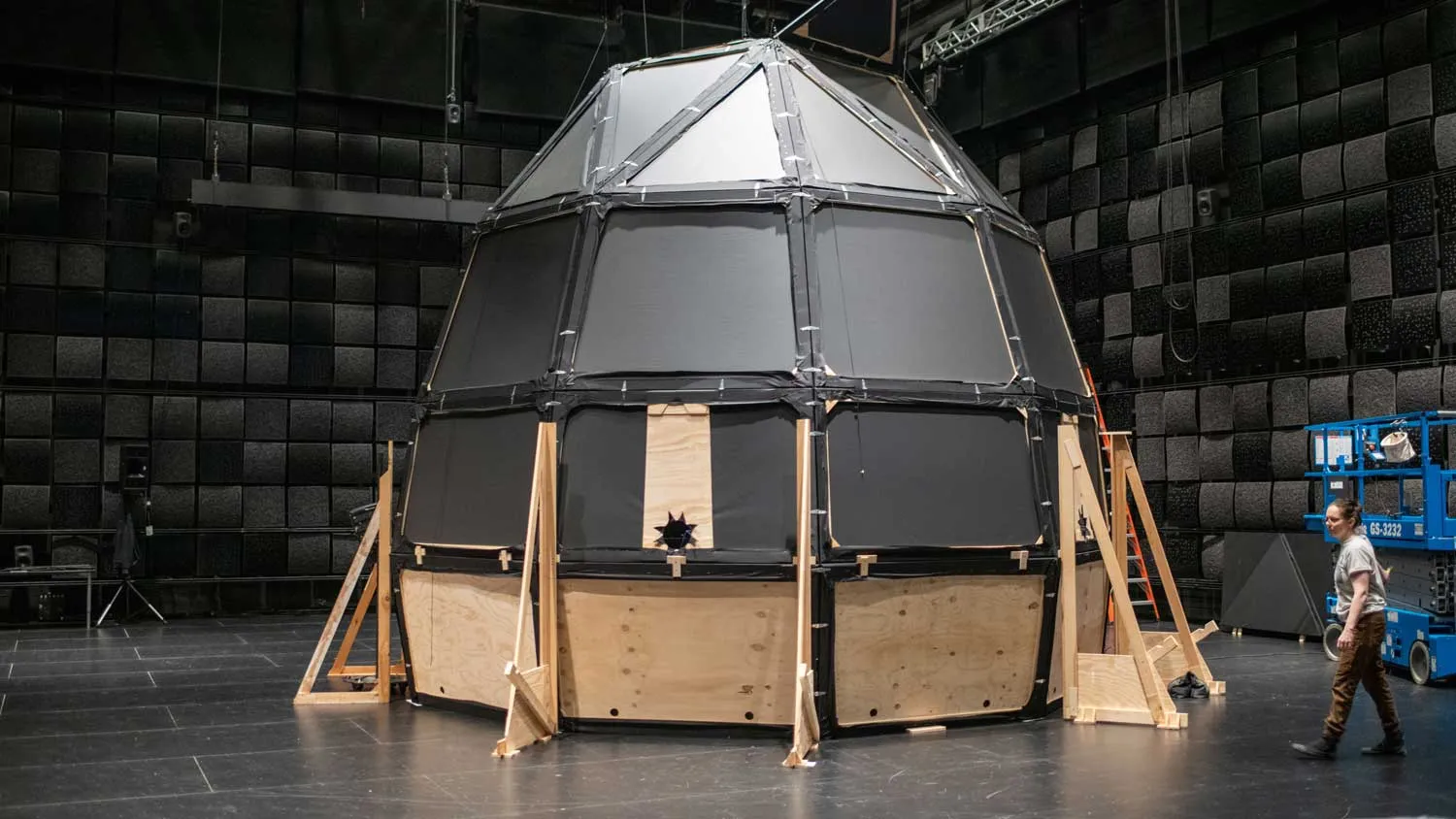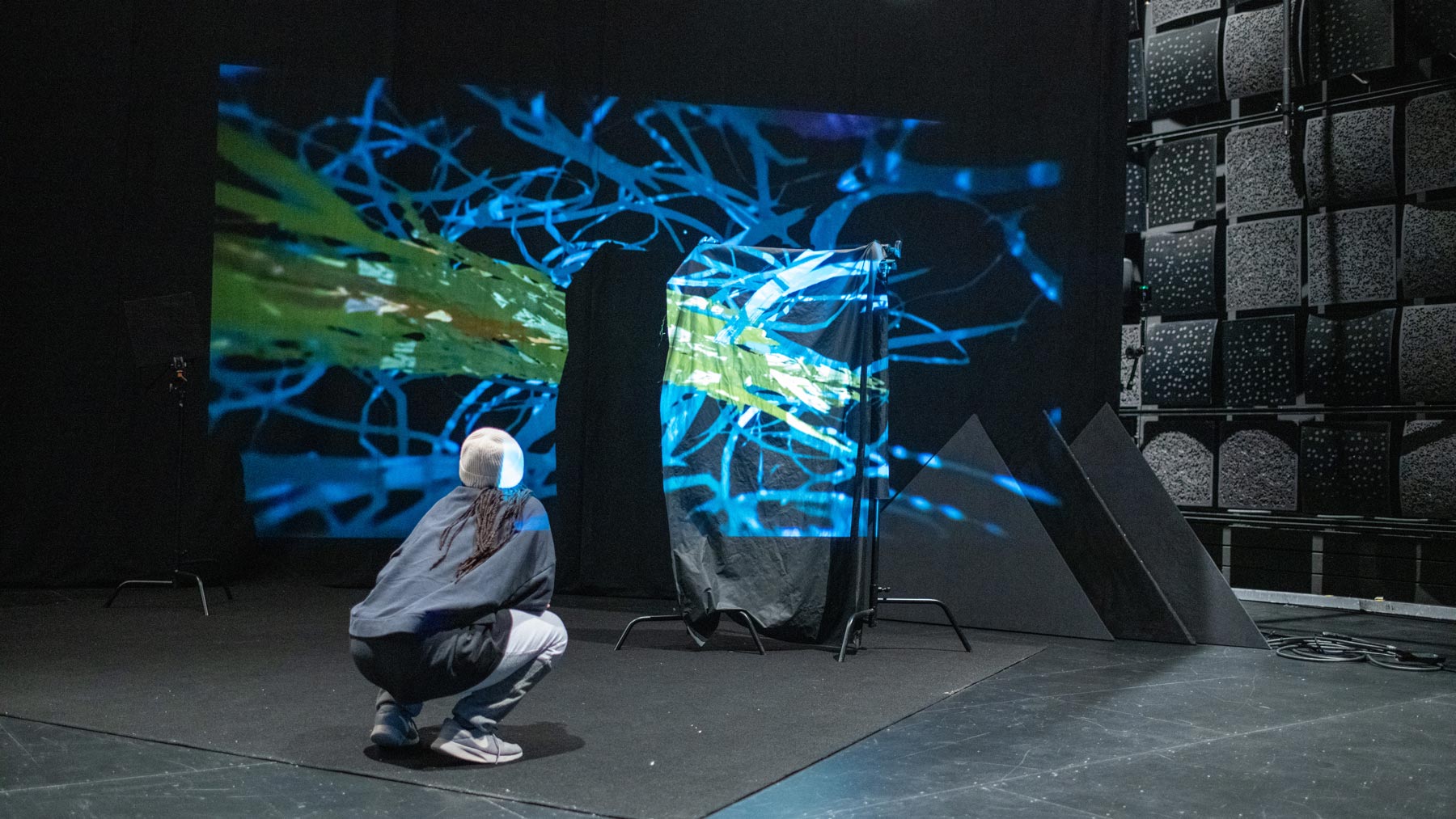
Sage Ni’Ja Whitson Illuminates Our Fear of the Dark
There’s a spaceship, called a space|ship, in one studio at EMPAC, the media center by Grimshaw Architects sitting like a space station at Rensselaer Polytechnic Institute, itself perched on a hilltop in Troy, New York. The space|ship sits in darkness, and it’s of darkness: its route is through colonial conceptions of the dark, and those who live and look like it, as dangerous; through investigations of how “dark matter” isn’t dark at all; through how society blankets Black, trans, and queer bodies in a terrified desire to make them invisible; through all this and into your own body so you can see yourself.
It’s the heart of Transtraterrestrial, an ambitious project by multidisciplinary artist Sage Ni’Ja Whitson that debuted at EMPAC on April 6. A culmination of a multi-year collaboration with curator Ashley Ferro-Murray, the show begins with a hushed entrance into the vast studio. A spotlight finds Whitson approaching a pile of collard greens and making them into percussion. During the performance, the space|ship beckons in shadows, but first Whitson takes a podium and addresses us, a dim spotlight illustrating their position.
Their welcoming offers a framework to experience what’s to come: “The blackest black is underneath my mother’s fingernails and is a pulpit hot in Ohio,” they say. “The blackest black is my gender transition and the making of myself; a corner store in Detroit or a bodega in Brooklyn.” Above them hang large palm sculptures, and if the mind initially drifts toward ideas of strange fruit, of the ongoing reality of lynching in America, Whitson installed them to lead the mind forward: “They are objects in space that become Black bodies in flight.”
We’re instructed to form small groups, to place one hand on each other’s shoulder, to allow Whitson to walk us backwards into the dark space|ship. The direction is influenced by their study of Yorùbá cosmology. “They walk into sacred spaces backwards,” Whitson says. “So the spiritual download is to treat the interiority of the spaceship as a sacred space.” In the studio under their warm authority, we encounter utter darkness. We lay down on drifts of cork. The absence of light is disembodying and comforting. Some found it disturbing. For people with hyper-monitored visual appearances, for people in Black and trans bodies especially, this might be an opportunity to have a moment in a body that isn’t seen, and see what happens.
And what happens is moving. Whitson built the space|ship with DNA Architecture + Design’s Valéry Augustin and EMPAC integration engineer Gordon Clement, and its contours gradually emerge as Whitson guides us through breath and brain prompts. Original geodesic concepts were too laden with allusions; here, they crafted triangular panels that shift in recession and protrusion. “It needed to read curvy, linear, and organic,” they say. “It needed to resemble a drum.” Composer Douglas R. Ewart and sound engineer Davu Seru helped build a resonant audio landscape to play it. It’s covered in stretches and strips of LiteOut Black fabric, which form the blackout.
The blackout becomes a screen. Whitson collaborated with VR technologist Joshua Ott on software that allows them to create VR effects on walls and ceilings in real time. Vertiginous lines and geometric expanses melt the space, crack it, rebuild it, and throw the darkness into relief. After, we’re led into a studio for aftercare. A sofa offers a camera like a confessional; a long ream of paper is a page for remembrances. There are chairs in light and in shadow, and tea. We all remain there for a long time, resisting the urge to return to the real world. Fear of the dark is a dawning realization: what we might be afraid of is the light.
“The ways I’ve been trying to treat the dark, to treat darkness, is the way I want to support people to treat and rethink about Blackness,” Whitson says. While the space|ship stayed just for one weekend, they conceived it as a “prequel and premiere” for other landings globally. Take the trip.

Main Image: Production still: Whitson's space|ship installed in Studio 1–Goodman during their residency in April, 2023. Courtesy the artist. Photo: Michael Valiquette/EMPAC.
